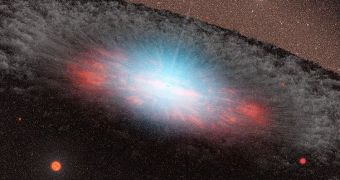A team of astronomers announce the discovery of a supermassive black hole in the nearby galaxy NGC253, which is located in the Sculptor Group of Galaxies. The massive object is very similar in mass and diameter to Sagittarius A*, the black hole at the center of our own galaxy.
Granted, astrophysicists don't know for sure that Sagittarius A* is a black hole. They first identified it as an extremely bright radio source, and hypothesized that the radiations were being produced by such a dark behemoth feeding on interstellar gas and unlucky stars.
Black holes can grow to impressive dimensions, getting to a point where they weigh billions of times the mass of the Sun. They therefore exert an unbelievably-strong gravitational pull on their surroundings, trapping very unlucky stars in their grip, and eventually dismembering and feeding off them.
Sometimes, this process can lead to the release of radiation or matter jets from the poles of the black hole. Such occurrences are very rare, and occur only when massive volumes of matter make their way through the event horizon from the behemoth's accretion disk, Daily Galaxy reports.
“Most of these are sleeping cosmic beasts, just sitting there. So we have to scan the skies to see those very rare times when there's a burst of radiation as the black hole feeds,” explains University of California in Los Angeles (UCLA) astronomy and physics professor, Andrea Ghez.
The data used in this investigation were collected by the NACO instrument (a merger of the Nasmyth Adaptive Optics System and Near-Infrared Imager and Spectrograph devices) on the Very Large Telescope (VLT). The telescope is located at the European Southern Observatory's (ESO) Paranal facility.
Additional data were provided by the NASA/ESA Hubble Space Telescope and the Very Large Array (VLA) and the Very Large Baseline Interferometer (VLBI) observatories. This allowed scientists to look at the black hole in NGC 253 in multiple wavelengths.
Studies such as this can be used to gain additional insight into the origins of galaxies, star systems and black holes. By comparing data on Sagittarius A* to data of the newly-found supermassive black hole, astronomers can retrace the evolutionary history of the two objects.

 14 DAY TRIAL //
14 DAY TRIAL //